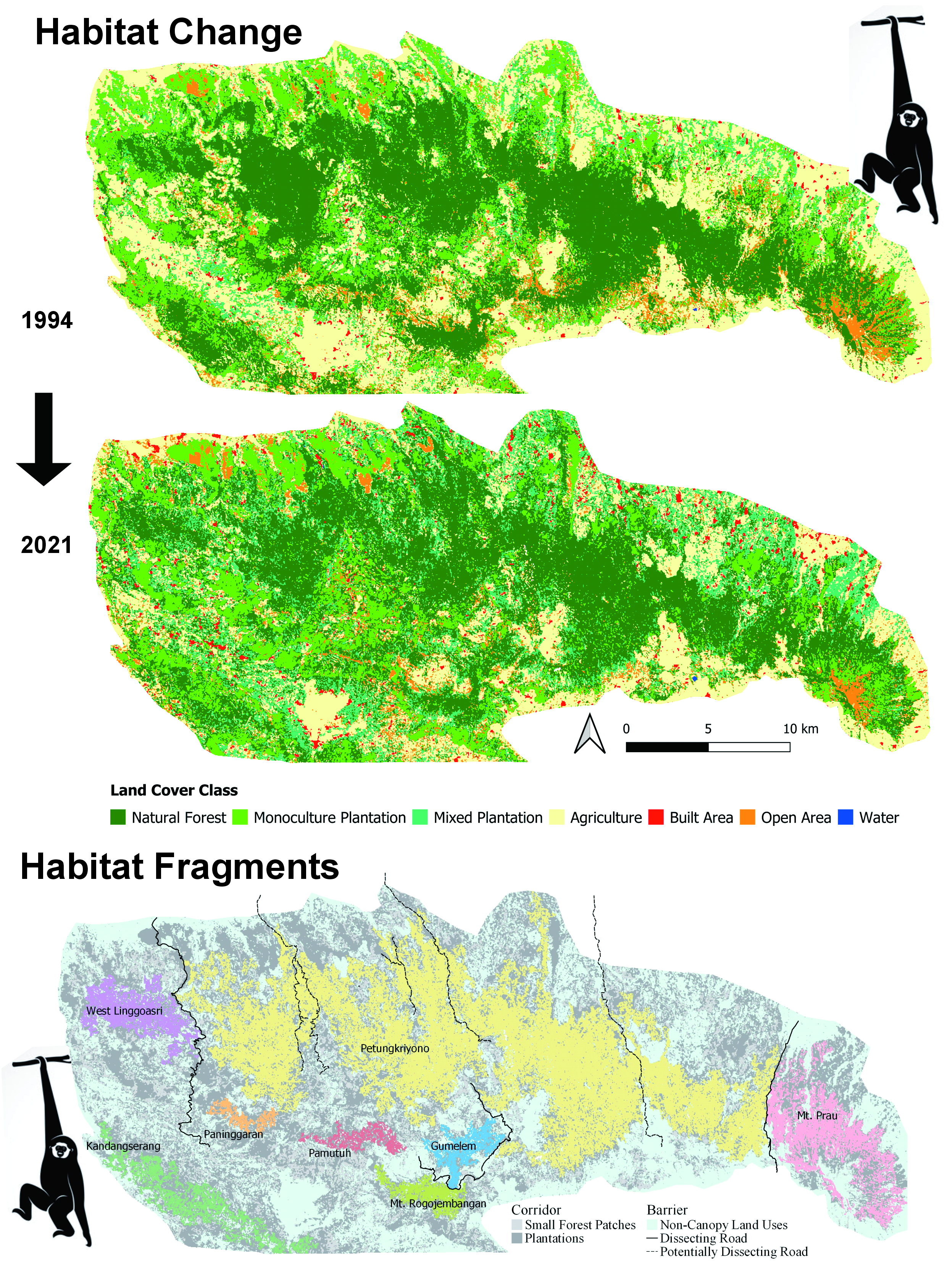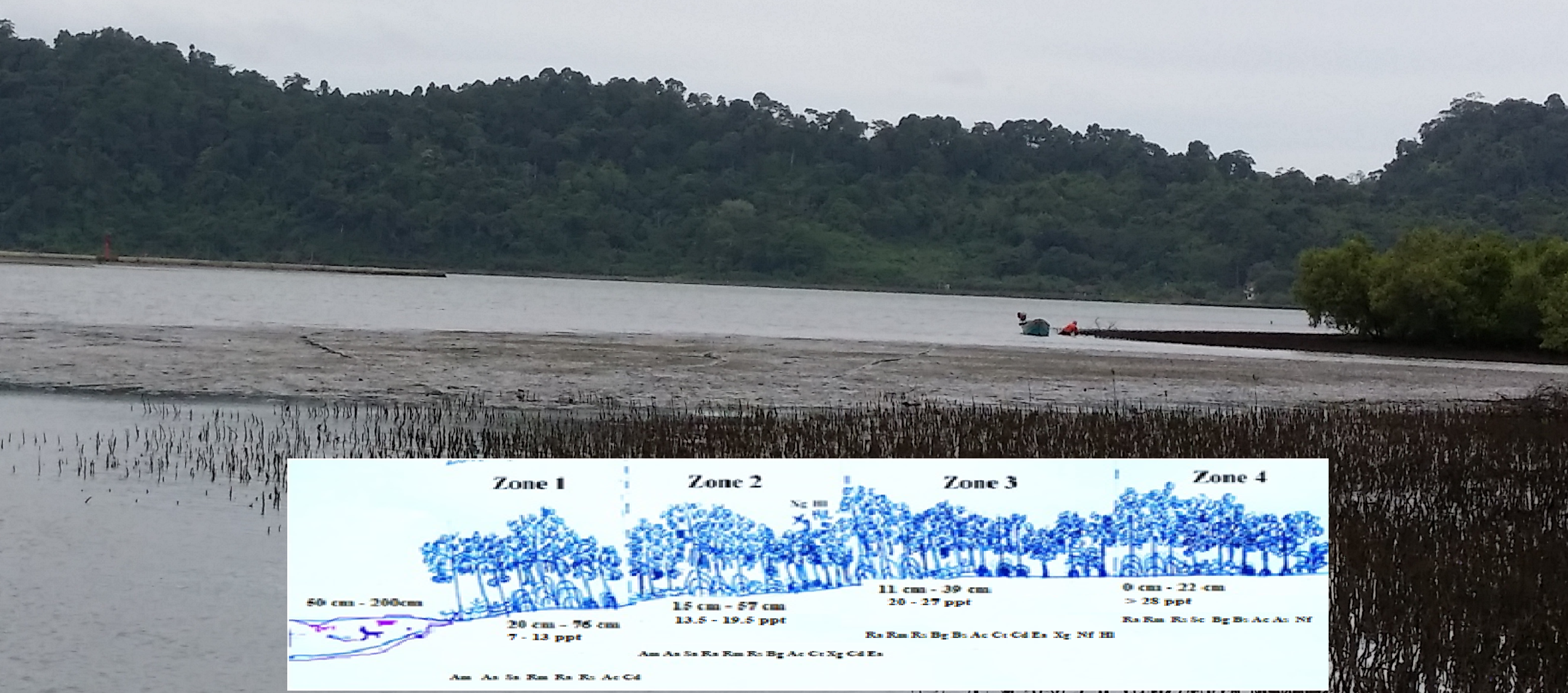Abstract
At a landscape level, forest transitions have complex spatial heterogeneity characteristics, thus the causes, driving force, typology and specific profile characteristics need to be considered for managing and mitigating forest transition. This paper describes how the diversity of forest transition characteristics was grouped and how the characteristic of group was identified. Typology classes within water catchment areas in Riau, North Sumatera and West Sumatera Provinces, Indonesia were investigated by considering social, economic and biophysical aspects. The main study objective was to develop a forest transition typology at a landscape level. The model typology was derived from a clustering method with the Standardized Euclidean Distance. The study found that the most significant factor which successfully differentiated the typology of forest transition into two typologies was the population growth having approximately 92% of overall accuracy. The first typology (typology 1) could be categorized as rapid forest transition, while the typology 2 was categorized as slow forest transition. The study suggested that the management and mitigation of the impacts of the forest transition should be conducted by considering the landscape typology as a function of the profiles for each typology.
References
Albar I, Jaya INS, Saharjo BH, Kuncahyo B. 2016. Spatio-temporal typology of land and forest fire in Sumatera. Indonesian Journal of Electrical Engineering and Computer Science 4:83−90. https://doi.org/10.11591/ ijeecs.v4.i1.
Antle JM, Heidebrink G. 1995. Environment and development: Theory and international evidence. Economic Development and Cultural Change 43:603−625.
Bae JS, Joo RW, Kim Y-S. 2012. Forest transition in South Korea: Reality, path, and drivers. Land Use Policy 29:198−207. https://doi.org/10.1016/j.landusepol. 2011.06.007
Barbier EB, Burgess JC. 2001. The economics of tropical deforestation. Journal of Economic Surveys 15:413−433. https://doi.org/10.1111/1467-6419.00144
Culas RJ. 2012. REDD and forest transition: Tunneling through the environmental Kuznets curve. Ecological Economics 79:44−51. https://doi.org/10.1016/j.ecole con.2012.04.015
Easterlin RA. 1967. Effects of population growth on the economic development of developing countries. The ANNALS of the American Academy of Political and Social Science 369:98−108. https://doi.org/10.1177/ 000271626736900110.
Ehrhardt-Martinez K, Crenshaw EM, Jenkins JC. 2002. Deforestation and the environmental Kuznets curve: A cross-national investigation of intervening mechanisms. Social Science Quarterly 83:226−243. https://doi.org/10. 1111/1540-6237.00080.
Ewers RM. 2006. Interaction effects between economic development and forest cover determine deforestation rates. Global Environmental Change 16:161169. https://doi.org/10.1016/j.gloenvcha.2005.12.001.
FAO. 2015. Global forest resource assesment 2015. Rome: Food and Agriculture Organization of The United Nations
Geist HJ, Lambin EF. 2002. Proximate causes and underlying driving forces of tropical deforestation. BioScience 52:143150. https://doi.org/10.1641/0006-3568(2002)052[0143:pcaudf]2.0.co;2.
Grainger A. 1995. The forest transition: An alternative approach. Area 27: 242251.
Hardin G. 1968. The tragedy of the commons. Science 162:1243−1248. https://doi.org/10.1126/science.162. 3859.1243
Hosonuma N, Herold M, De Sy V, De Fries RS, Brockhaus M, Verchot L, Angelsen A, Romijn E. 2012. An assessment of deforestation and forest degradation drivers in developing countries. Environmental Research Letters 7:1−12. https://doi.org/10.1088/1748-9326/7/4/044009.
Jaya INS. 2015. Analisis Citra Digital: Prespektif Penginderaan Jauh untuk Pengelolaan Sumberdaya Alam. Bogor: IPB Press.
Kanninen M, Murdiyarso D, Seymour F, Angelsen A, Wunder S, German L. 2009. Apakah hutan dapat tumbuh di atas uang?: implikasi penelitian deforestasi bagi kebijakan yang mendukung REDD. Bogor: CIFOR
Kirk D. 1996. Demographic transition theory. Population Studies 50:361−387. https://doi.org/10.1080/003247 2031000149536.
Köthke M, Leischner B, Elsasser P. 2013. Uniform global deforestation patternsAn empirical analysis. Forest Policy and Economics 28:23−37. https://doi.org/10. 1016/j.forpol.2013.01.001.
Kuznets S. 1955. Economic growth and income inequality. The American Economic Review 45:1−28.
Lambin EF, Meyfroidt P. 2011. Global land use change, economic globalization, and the looming land scarcity. Proceedings of the National Academy of Sciences of the United States of America 108:3465−3472. https://doi.org/ 10.1073/pnas.1100480108.
Mather AS. 1992. The forest transition. Area 24:367−379.
Mather AS. 2007. Recent Asian forest transitions in relation to forest transition theory. International Forestry Review 9:491−502. https://doi.org/10.1505/ifor.9.1.491.
Mather AS, Fairbairn J. 2000. From floods to reforestation: The forest transition in Switzerland. Environment and History 6:399–421.
Mather AS, Fairbairn J, Needle CL. 1999a. The course and drivers of the forest transition: The case of France. Journal of Rural Studies 15:65−90. https://doi.org/10. 1016/s0743-0167(98)00023-0.
Mather AS, Needle CL. 1998. The forest transition: A Theoretical basis. Area 30:117−124.
Mather AS, Needle CL. 2000. The relationships of population and forest trends. The Geographical Journal 166:2−13.
Mather AS, Needle CL, Fairbairn J. 1999b. Environmental Kuznets curves and forest trends. Geography 84:55−65.
MoEF. 2017. Rekalkulasi Penutupan Lahan 2015. Jakarta: Ministry of Environment and Forestry.
Purnomo H, Shantiko B, Sitorus S, Gunawan H, Achdiawan R, Kartodihardjo H, Dewayani AA. 2017. Fire economy and actor network of forest and land fires in Indonesia. Forest Policy and Economics 78:21−31. https://doi.org/ 10.1016/j.forpol.2017.01.001 .
Ranganathan S, Swain RB, Sumpter DJT. 2015. The demographic transition and economic growth: implications for development policy. Palgrave Communications 1:1−8. https://doi.org/10.1057/pal comms.2015.33
Rijal S, Saleh MB, Jaya INS, Tiryana T. 2016. Deforestation profile of regency level in Sumatera. International Journal of Sciences: Basic and Applied Research 25:385−402.
Rudel TK, Coomes OT, Moran E, Achard F, Angelsen A, Xu J, Lambin E. 2005. Forest transitions: towards a global understanding of land use change. Global Environmental Change 15:23−31. https://doi.org/10.1016/j.gloenvcha. 2004.11.001.
Rudel TK, Schneider L, Uriarte M. 2010. Forest transitions: An introduction. Land Use Policy 27:95−97. https://doi.org/10.1016/j.landusepol.2009.09.021.
Samsuri, Jaya INS, Kusmana C, Murtilaksono K. 2014. Restoration index of degraded tropical forest landscape in Batang Toru Watershed, North Sumatera Indonesia. Biotropia 21:111−124. https://doi.org/10.11598/btb. 2014.21.2.5.
Setiawan H, Jaya INS, Puspaningsih N. 2015. Model spasial deforestasi di Kabupaten Konawe Utara dan Konawe Provinsi Sulawesi Tenggara. Media Konservasi 20:166−176.
Suhendang E. 2013. Pengantar Ilmu Kehutanan. Bogor: IPB Press.
Sulistiyono N, Jaya INS, Prasetyo LB. 2015. Spatial model of deforestation in Sumatera Islands using typological approach. Jurnal Manajemen Hutan Tropika 21:99−109. https://doi.org/10.7226/jtfm.21.3.99.
Turner MG. 1989. Landscape ecology: The effect of pattern on process. Annual Review of Ecology and Systematics 20:171−197. https://doi.org/10.1146/annurev.es.20. 110189.001131.
Wijaya PA, Saleh MB, Tiryana T. 2015. Spatial model of deforestation in Jambi Province for the period 1990–2011. Jurnal Manajemen Hutan Tropika 21:28−137. https://doi.org/10.7226/jtfm.21.3.128.
Xu J, Yang Y, Fox J, Yang X. 2007. Forest transition, its causes and environmental consequences: empirical evidence from Yunnan of Southwest China. Tropical Ecology 48:137−150.
Yan H, Zhan J, Zhang T. 2011. Resilience of forest ecosystems and its influencing factors. Procedia Environmental Sciences 10:2201−2206. https://doi.org/ 10.1016/j.proenv.2011.09.345.
Authors

This work is licensed under a Creative Commons Attribution 4.0 International License.
Jurnal Manajemen Hutan Tropika is an open access journal which means that all contents is freely available without charge to the user or his/her institution. Users are allowed to read, download, copy, distribute, print, search, or link to the full texts of the articles in this journal without asking prior permission from the publisher or the author. This is in accordance with the Budapest Open Access Initiative (BOAI) definition of open access.



